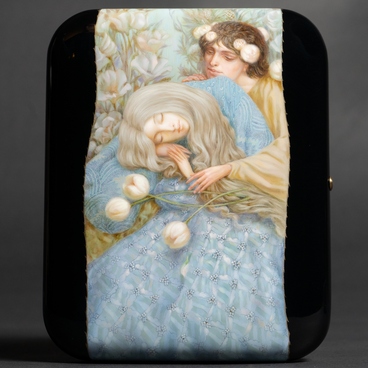Masters of all four centers of lacquer miniature painting often turned to the landscape genre. If in Palekh, Kholuy and Mstyora it was part of the composition — a beautiful background that complements the plot; in Fedoskino, the landscape acquired an independent meaning. To a large extent, this was due to the beauty of the village itself, which is picturesquely spread out on the banks of the Ucha River near Moscow.
Over the long history of the craft, the style of landscape painting has constantly changed. The miniatures of the Lukutin factory introduced motifs of natural landscapes which were copied from famous paintings. Over time, artists have developed and enriched this genre, and nowadays works of Fedoskino masters present an entire world of images. Each artist has their own favorite motif: mysterious forest thickets where one can meet magical spirits, old vanished Russian cities, majestic architectural views, and lyrical landscapes of Central Russia. Igor Isaev, Alexander Fedorov, Tatiana Dmitrieva, Vladimir Monashov, Sergey Kozlov are just a few of contemporary artists who celebrate the beauty of their native land.
The miniature ‘Haystack’ was painted by Sergey Kozlov in 1980. The artist chose a vertical box for his work. A haystack is depicted in the center of the composition. The master applied gold leaf by gluing it on thin strands of dried varnish. This accidental technical solution turned out to be quite spectacular: the painting glows so brightly, as if the dry grass has absorbed the warm energy of the sun. In the distance, on a bank of the river, the artist depicted a small village with izbas (wooden houses), where the evening light is lit in the windows — a symbol of joy and comfort. Fishermen are painted on both banks of the river, while cows graze a little closer in the meadow.
Nature in Fedoskino miniatures looks simple and lively, but to achieve this apparent simplicity, artists work on one painting for months, as landscapes in lacquer painting have their own peculiarities in comparison to ordinary paintings: initially they are placed not on a plane, but on a three-dimensional object. Such compositions should have an internal completeness and be proportionate to the object itself, although in some cases it is also allowed for the image to continue onto the adjacent sides of a box or a case.
Over the long history of the craft, the style of landscape painting has constantly changed. The miniatures of the Lukutin factory introduced motifs of natural landscapes which were copied from famous paintings. Over time, artists have developed and enriched this genre, and nowadays works of Fedoskino masters present an entire world of images. Each artist has their own favorite motif: mysterious forest thickets where one can meet magical spirits, old vanished Russian cities, majestic architectural views, and lyrical landscapes of Central Russia. Igor Isaev, Alexander Fedorov, Tatiana Dmitrieva, Vladimir Monashov, Sergey Kozlov are just a few of contemporary artists who celebrate the beauty of their native land.
The miniature ‘Haystack’ was painted by Sergey Kozlov in 1980. The artist chose a vertical box for his work. A haystack is depicted in the center of the composition. The master applied gold leaf by gluing it on thin strands of dried varnish. This accidental technical solution turned out to be quite spectacular: the painting glows so brightly, as if the dry grass has absorbed the warm energy of the sun. In the distance, on a bank of the river, the artist depicted a small village with izbas (wooden houses), where the evening light is lit in the windows — a symbol of joy and comfort. Fishermen are painted on both banks of the river, while cows graze a little closer in the meadow.
Nature in Fedoskino miniatures looks simple and lively, but to achieve this apparent simplicity, artists work on one painting for months, as landscapes in lacquer painting have their own peculiarities in comparison to ordinary paintings: initially they are placed not on a plane, but on a three-dimensional object. Such compositions should have an internal completeness and be proportionate to the object itself, although in some cases it is also allowed for the image to continue onto the adjacent sides of a box or a case.





